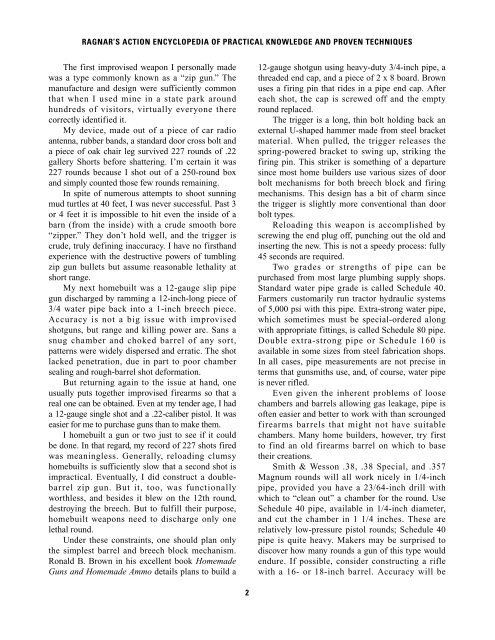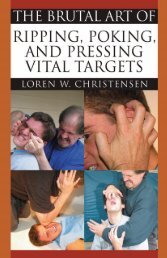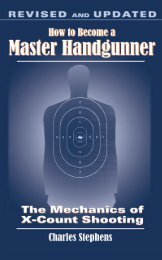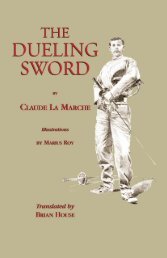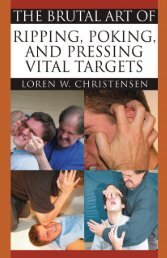Ragnar's Action Encyclopedia of Practical ... - Paladin Press
Ragnar's Action Encyclopedia of Practical ... - Paladin Press
Ragnar's Action Encyclopedia of Practical ... - Paladin Press
Create successful ePaper yourself
Turn your PDF publications into a flip-book with our unique Google optimized e-Paper software.
RAGNAR’S ACTION ENCYCLOPEDIA OF PRACTICAL KNOWLEDGE AND PROVEN TECHNIQUES<br />
The first improvised weapon I personally made<br />
was a type commonly known as a “zip gun.” The<br />
manufacture and design were sufficiently common<br />
that when I used mine in a state park around<br />
hundreds <strong>of</strong> visitors, virtually everyone there<br />
correctly identified it.<br />
My device, made out <strong>of</strong> a piece <strong>of</strong> car radio<br />
antenna, rubber bands, a standard door cross bolt and<br />
a piece <strong>of</strong> oak chair leg survived 227 rounds <strong>of</strong> .22<br />
gallery Shorts before shattering. I’m certain it was<br />
227 rounds because I shot out <strong>of</strong> a 250-round box<br />
and simply counted those few rounds remaining.<br />
In spite <strong>of</strong> numerous attempts to shoot sunning<br />
mud turtles at 40 feet, I was never successful. Past 3<br />
or 4 feet it is impossible to hit even the inside <strong>of</strong> a<br />
barn (from the inside) with a crude smooth bore<br />
“zipper.” They don’t hold well, and the trigger is<br />
crude, truly defining inaccuracy. I have no firsthand<br />
experience with the destructive powers <strong>of</strong> tumbling<br />
zip gun bullets but assume reasonable lethality at<br />
short range.<br />
My next homebuilt was a 12-gauge slip pipe<br />
gun discharged by ramming a 12-inch-long piece <strong>of</strong><br />
3/4 water pipe back into a 1-inch breech piece.<br />
Accuracy is not a big issue with improvised<br />
shotguns, but range and killing power are. Sans a<br />
snug chamber and choked barrel <strong>of</strong> any sort,<br />
patterns were widely dispersed and erratic. The shot<br />
lacked penetration, due in part to poor chamber<br />
sealing and rough-barrel shot deformation.<br />
But returning again to the issue at hand, one<br />
usually puts together improvised firearms so that a<br />
real one can be obtained. Even at my tender age, I had<br />
a 12-gauge single shot and a .22-caliber pistol. It was<br />
easier for me to purchase guns than to make them.<br />
I homebuilt a gun or two just to see if it could<br />
be done. In that regard, my record <strong>of</strong> 227 shots fired<br />
was meaningless. Generally, reloading clumsy<br />
homebuilts is sufficiently slow that a second shot is<br />
impractical. Eventually, I did construct a doublebarrel<br />
zip gun. But it, too, was functionally<br />
worthless, and besides it blew on the 12th round,<br />
destroying the breech. But to fulfill their purpose,<br />
homebuilt weapons need to discharge only one<br />
lethal round.<br />
Under these constraints, one should plan only<br />
the simplest barrel and breech block mechanism.<br />
Ronald B. Brown in his excellent book Homemade<br />
Guns and Homemade Ammo details plans to build a<br />
12-gauge shotgun using heavy-duty 3/4-inch pipe, a<br />
threaded end cap, and a piece <strong>of</strong> 2 x 8 board. Brown<br />
uses a firing pin that rides in a pipe end cap. After<br />
each shot, the cap is screwed <strong>of</strong>f and the empty<br />
round replaced.<br />
The trigger is a long, thin bolt holding back an<br />
external U-shaped hammer made from steel bracket<br />
material. When pulled, the trigger releases the<br />
spring-powered bracket to swing up, striking the<br />
firing pin. This striker is something <strong>of</strong> a departure<br />
since most home builders use various sizes <strong>of</strong> door<br />
bolt mechanisms for both breech block and firing<br />
mechanisms. This design has a bit <strong>of</strong> charm since<br />
the trigger is slightly more conventional than door<br />
bolt types.<br />
Reloading this weapon is accomplished by<br />
screwing the end plug <strong>of</strong>f, punching out the old and<br />
inserting the new. This is not a speedy process: fully<br />
45 seconds are required.<br />
Two grades or strengths <strong>of</strong> pipe can be<br />
purchased from most large plumbing supply shops.<br />
Standard water pipe grade is called Schedule 40.<br />
Farmers customarily run tractor hydraulic systems<br />
<strong>of</strong> 5,000 psi with this pipe. Extra-strong water pipe,<br />
which sometimes must be special-ordered along<br />
with appropriate fittings, is called Schedule 80 pipe.<br />
Double extra-strong pipe or Schedule 160 is<br />
available in some sizes from steel fabrication shops.<br />
In all cases, pipe measurements are not precise in<br />
terms that gunsmiths use, and, <strong>of</strong> course, water pipe<br />
is never rifled.<br />
Even given the inherent problems <strong>of</strong> loose<br />
chambers and barrels allowing gas leakage, pipe is<br />
<strong>of</strong>ten easier and better to work with than scrounged<br />
firearms barrels that might not have suitable<br />
chambers. Many home builders, however, try first<br />
to find an old firearms barrel on which to base<br />
their creations.<br />
Smith & Wesson .38, .38 Special, and .357<br />
Magnum rounds will all work nicely in 1/4-inch<br />
pipe, provided you have a 23/64-inch drill with<br />
which to “clean out” a chamber for the round. Use<br />
Schedule 40 pipe, available in 1/4-inch diameter,<br />
and cut the chamber in 1 1/4 inches. These are<br />
relatively low-pressure pistol rounds; Schedule 40<br />
pipe is quite heavy. Makers may be surprised to<br />
discover how many rounds a gun <strong>of</strong> this type would<br />
endure. If possible, consider constructing a rifle<br />
with a 16- or 18-inch barrel. Accuracy will be<br />
2


